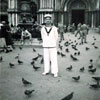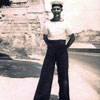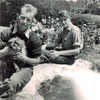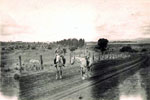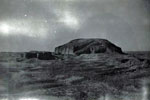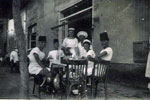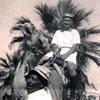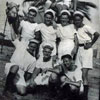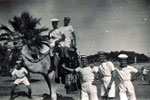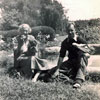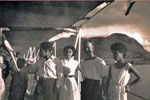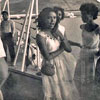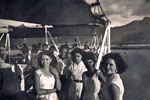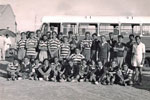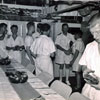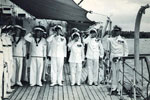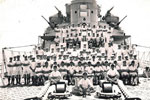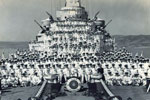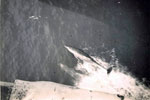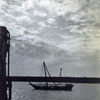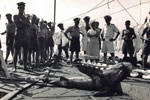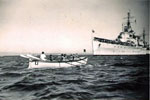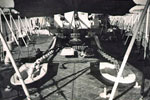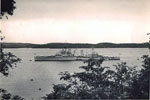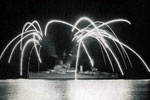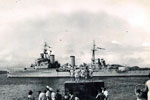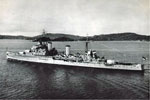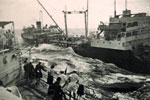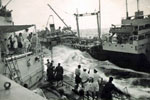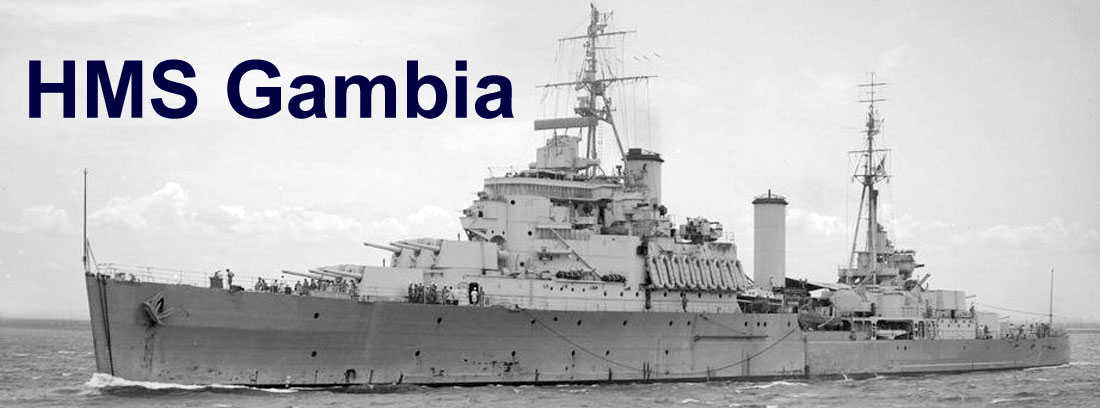
Keith Butler
Keith Butler served as an ordinary seaman D/J 932907 on HMS Gambia's 1955/56 commission.
Keith very kindly sent the following reminiscences and photographs for the site:
Some Reminiscences by Keith Butler.
I would first like to say a posthumous thank you to my shipmate Keith Best for his excellent memories of his time in Gambia [I need to try and find this article] during this commission. Reading his articles has brought back many memories and rekindled some of my own, so I owe it to Keith for showing me the way and I hope the following will also remind others on this commission of the good times that we had. It cannot always be said that a big ship was a happy ship, but Gambia certainly was, and this seems to apply to most if not all commissions judging from all that I have read and heard through the Association.
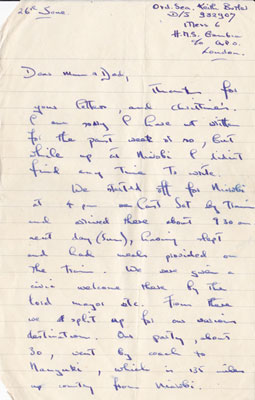
In August 2017, Keith Butler very kindly sent a copy of a letter he sent to his parents dated June 26, 1955. In it he describes a trip he and Steve Bentley made to Nanyuki, about 130 miles north of Nairobi, in Kenya.
Ordinary seaman Keith Butler
D/J 932907
Mess 6
HMS Gambia
CO GPO
London26th June
Dear Mum and Dad,
Thanks for your letter, and Christine's. I am really I have not written for the past week or so, but while up in Nairobi I didn't find any time to write.
We started off for Nairobi at 4pm last Saturday by train and arrived there about 9.30am next day (Sunday), having slept and had meals provided on the train. We were given a civic welcome there by the lord mayor etc. From there we split up for our various destinations. Our party, about 30, went by coach to Nanyuki, which is 135 miles up country from Nairobi.
There we were welcomed at the Silverbeck Hotel, where we were given tea. (We had dinner on the bus). From there we went to the various towns etc. where we were to stay. At first I was with a party who went to say at an army camp. I was there two days Sunday night, now and then. On the Monday we went to Buffalo Springs, which is about 60 miles away; on the way we saw a bit of game and took photographs.
Next day we went up to about 13,000 up Mount Kenya in a Land Rover. We went through the forest round the base, there are some of the big game elephants, and so on, but although we saw plenty of tracks we saw no sign of them. It is of course at Mau-Mau riding area and for this reason and the other we went armed.
On Tuesday evening a friend of mine and myself went onto a farm not far away ; there we had our own room and bathroom, called each morning with a cup of tea etc. Next day (Wednesday) we went into town (Nanyuki) and in the afternoon we tried to repair the generator which provided electricity to the town but as we failed we had to revert to the paraffin lamps. By the way the person who owned the farm was quite an elderly lady you lived by herself, her son is at present Captain of the HMNZN Black Prince, her brother was also a Naval Captain.
Next morning (Thursday) we went on a six mile horse ride with her daughter in law who have the next farm. In the afternoon we went trout fishing in the stream which runs between the two farms, we didn't catch anything.
During the Thursday night a group of Mau-Mau attacked the farm taking a cow. (This was the second attack, she had one on the previous Saturday losing three heifers).
That morning we went out with the trackers to track down the Mau-Mau. It appeared from the tracks that they took all the cattle at first but all but the one managed to get back. We tracked for about 1½ miles when we found the remains of the dead cow. They had taken everything except the intestines and stomach, which said the trackers is very uncommon, as they usually just take the legs, ?????? and rump, leaving the rest. After this the gang (about 10 in number) split up and it was here that we turned back for lunch.
That afternoon we left the farm to join up with the others in the district at the Silverbeck, there we had dinner and then boarded the train for Nairobi. We slept the night on it while it was still in the station at Nanyuki, leaving first thing on Saturday morning. An interesting point about the Silverbeck is that the Equator runs through the middle of the bar.
Saturday 5pm we left Nairobi for Mombasa and arrived here this morning at 9.30am.
Well that's the tale, we leave here tomorrow for Zanzibar so until then I will say cheerio,
Love Keith
P.S. I apologize to Christine for not writing personally but this is too bad as well, will write later to her.
Keith also sent this description of the trip:
Kenya. (14th to 27th June, 1955)
I will start on that train that Keith described taking the ship's Concert Party from Mombasa to Nairobi; as well as the Concert Party there were also about thirty other members of the ship's company on the train, myself included, who were destined to travel on to Nanyuki which is about 130 miles north of Nairobi. This involved a further train journey, and on our arrival we gathered in the Silverbeck Hotel, which sits astride the equator (it runs through the bar and marked with a brass line), to be welcomed by local residents who were to be our hosts, they were mainly local farmers, but some of us were to stay with a Company of the Northumberland Fusiliers under canvas close to the foothills of Mount Kenya. Steve Bentley and I were due to stay on a farm, but the night before we arrived it was raided by the Mau-Mau so this was not possible. We therefore joined the others who were to stay with the Northumberlands.
During our stay with the army, who were there to guard against the Mau-Mau, we went on a safari in an army truck into the Marsabit National Park. As we descended into the Park, past Archers Post, we were able to look north and see the Ethiopian Plateau on the horizon. Once into the reserve we were able to stalk zebras, giraffes and Thompson gazelles. We had our lunch by a pool in which Ava Gardner had swum whilst she was making a film! Our return journey was in the rain and we sang to cheer ourselves up.
Another outing took us up into the foothills of Mount Kenya in Land Rovers to about 14,000ft, after which we walked up another 500ft. I recall that I had been issued with a rifle, with anti-flash muzzle, and ten rounds just in case we came across the Mau-Mau or rampaging buffalo – we didn't!!
Next day Steve and I were told that another farm had offered us a place to stay, and we were duly delivered to the home of Mrs Bullock. She in fact was retired and lived in a bungalow just across the valley from the family farm run by her daughter and son-in-law, Mr & Mrs Whitehead. She also had a son, a Captain RN, then serving on loan with the RNZN. She lived alone, but had a Kikuyu servant, and she kept a revolver in case of a Mau-Mau attack. She had a target on a tree in the garden to keep her hand in with the revolver!! There was a photo of her on the website with her parrot.
Whilst there we tried fly fishing for trout in the stream, no success! And we also went on a horse ride from the farm. Steve had ridden before but I was a complete novice and I had to hang on to the horse's mane for dear life when it decided to follow the others at a full gallop back to the farm.
Our last day there was probably the most memorable. We awoke to the news that the Mau-Mau had raided Mrs Bullock's paddock and driven away the six cows that were grazing there. Most of the cows had returned, but after breakfast a police inspector and two native trackers arrived to try and hunt the Mau-Mau down. Steve and I were invited to join them. At first the tracks were relatively easy to follow with six sets of cow prints; these then dwindled to three sets of prints as cows had escaped from the raiders and made off back to the paddock. After a mile or so we lost all tracks, and like Baden Powell said to do in Scouting for Boys, it was decided that the inspector and a tracker would circle to the left, the other tracker and myself would circle right leaving Steve to stay put. Myself and the tracker eventually found the tracks of two of the cows heading back towards the paddock. We returned to meet up with the others to find no Steve and the Inspector and tracker returning across the field. They had found a barbed wire fence slashed with a panger, usually a sign of Mau-Mau activity. We were debating what to do when Steve turned up having decided to walk on ahead to see what he could find, and find something he did. About 150 yards further ahead he had come across a waterless clay pit across which were the clear footprints of two barefooted men and one cow. We skirted the clay pit and about fifty yards further on found the entrails of one cow. The Inspector told us that the Mau-Mau were now very short of food, hence they had taken all of the cow except the entrails. He also explained that raids on farms had by then become nearly always for food. Lunch time was approaching, and we were leaving the farm that afternoon, so we returned leaving the police to carry on following the tracks.
Later that day, all the Nanyuki contingent met at the Silverbeck Hotel for dinner, generously paid for by our hosts. We learnt that the police had lost the Mau-Mau trail so called off that particular hunt. After dinner we spent the night in the hotel bar singing with our hosts until we boarded the train. We spent the night sleeping in the siding and were served breakfast before the journey to Nairobi where we met up with the concert party for the return to Mombasa.
Keith, in his travelogue, indicates that we went from Mombasa direct to the Persian Gulf. In fact we went from Mombasa to Zanzibar then on to Dar-es Salaam in the then Tanganika before setting off back to Trincomalee, calling in on the Seychelles Islands between 13th and 20th July.
It was not probably common knowledge on board, but the Chaplain, Rev. H W Welsh, had gathered together a few old Boy Scouts and formed a Deep Sea Rovers troop, and arranged a few meetings with local Scout troops in our ports of call. One such meeting was at Zanzibar where we were shown the site of the old slave market and then visited an orange grove (lovely fresh oranges straight off the tree!). There were also clove trees, and we each bit into a clove! An old building on the grove had been taken over by a species of large bats, and the door was gently opened to reveal hundreds of bats hanging from the roof, what a sight for Sir Richard Attenborough.
The stop over in the Seychelles provided lots of opportunities for beach parties and banyans. It should be remembered that we were visiting all these places around the Indian Ocean before the days of package holidays and we had the great benefit of seeing them before they were spoilt by tourism, and all at the expense of HMG.
We crossed the line northwards on the 22nd July at 1000hrs. It was on this crossing that most of the crew were introduced to King Neptune and his court.
I have a record that we sailed a total of 6,315 nautical miles on the trip from Trinco to Mauritius and back via East Africa.
Before setting off for the Gulf, we stayed at Trinco for several weeks, during which time we took part in Exercise JET (Joint Exercises Trincomalee) in which RN frigates from the Gulf, and ships of the Indian, Pakistani and Ceylonese navies participated. We also enjoyed a week's local leave in the tea hills at Diyatalawa.
Persian Gulf
We called in at Columbo for a few days en-route to the Persian Gulf, our next stop being Khor Korwai(?) to drop off mail at the signal station on the Strait of Hormuz, which also gave the C in C ( Vice Admiral Norris), who had his barge rigged for deep sea fishing, to have yet another chance to flex his rods. Incidentally, the C in C caught so many fish, which were stored in the ships deep freeze, that the whole ships company was able to have a fish supper on at least one occasion – that is a lot of fish and included tuna and sword fish.
After further stops at Bahrain and Kuwait we arrived at Basra on the Shatt al-Arab. What a difference between the welcome we received to that more recently experienced by our servicemen and women in the recent Gulf wars. The only shots we fired were blanks in the form of gun salutes, but we made a good show of these, saving them all up for one day, the day we left Basra. (It must be remembered that in those days Iraq was ruled by King Faisal and Iran by the Shah). As we departed from Basra we fired a National Salute to Iraq; later, having moved downstream and across the Shatt, en route to Abadan, we fired a National Salute to Iran. (The Iranian border meets the Shatt about halfway between Basra and Khoramshah) As we passed Khorramshah, we fired respectively 19 gun salutes to the C in C Persian Navy and the C in C Persian Army. A total of 80 rounds in one day. Is this a record I ask? Each salute was of course returned to our C in C, as 15 gun salutes.
During the commission the Chaplain had built up a goodly party of Servers to assist at the daily Communion services held in the ship's chapel. Only when the Chaplain was on local leave was a service not held, could this be another record? As a reward for this dedication the Rev. Welsh organised two trips whilst we were at Basra, both with Biblical connections and both from the Old Testament.
Ur of the Chaldees
Ur is mentioned in the Bible (Gen. 11, 28-31), and is notable as the birthplace of Abraham. Abraham lived during the first half of the 20th century, B.C. though the history of Ur goes back to about 4000B.C. Abraham left Ur and journeyed NW along the Euphrates valley to Harran (near Lake Assad) before turning S into Canaan where he settled for most of the rest of his life.
I was particularly interested in Ur as the first history book we had at school was titled "From Ur to Rome". Ur was excavated over seven years, during the winters from 1922-29, by a combined expedition from the Museum of Pennsylvania and the British Museum led by Sir C Leonard Woolley.
One of the interesting aspects of his excavations was the discovery of an 8 ft. thickness of silt between two layers of ruins. This was an indication of a great flood which was dated as being not later than 3200B.C. Was this Noah's flood? The ark is said to have come to rest on mount Ararat which is in the mountain range from which the Tigris & Euphrates flow.
Our journey to Ur was by two taxis, American limos, and once we were out of the city the main road to Baghdad in those days was just a track in the desert with little or no marking except the odd boulder. If one strayed from the beaten track it was quite possible to get trapped in loose sand, and on the return journey this actually happened to one taxi and we all had to get out and push! At another point the driver pointed out a convoy of army lorries going in the same direction, on the same road, but about half a mile on our port beam. As I remember, they were the only other vehicles we saw going and returning out in the desert.
Shortly before we arrived at Ur we stopped at a road side building that was beside the railway between Basra & Baghdad. Here we were served with tea – no milk, in very small cups. As we approached Ur we stopped at the top of a slight incline from where we were able to see the Ziggurat of Ur a mile or two ahead.
The site was guarded by a lone tribesman in typical Arabic clothes and sporting an ancient rifle. He did not seem too interested in our arrival and did not take any interest in what we did.
The site was dominated by the Ziggurat, which are features peculiar to Sumerian architecture. The Sumerians probably came originally from further east and their bone structure indicates that they were of Indo European stock, similar to Caucasian man. Hence they were likely to have come from a hilly region. As the desert was virtually flat they built artificial hills, Ziggurats, so that they could carry on their tradition of worshipping their gods on high places. There was also a later Ziggurat at Babylon similar to that at Ur, but larger; however that at Ur is the best preserved. Later, in the Hebrew tradition, they became the "Tower of Babel".
At the foot of the Ziggurat was the temple of Nannah the Moon God, which formed the main entrance onto the Ziggurat, which was originally topped with a tower. The complete structure measures about 200 x 150 feet was originally 70 feet high. It is a solid mass of brickwork, the core being unbaked brick and faced with an 8 feet thickness of baked brick set in bitumen.
We scrambled around the excavations looking at the remains of houses, including some from the time of Abraham, the temple of E-Nun–mach and the Temenos Wall of Nebuchadnezzar, king of Babylon from 605-562 B.C. Most of us picked up bits of pottery, nothing complete, only shards, but it is interesting that the better pottery that was painted came from the excavations beneath the flood silt mentioned above, and therefore the oldest. That from above flood silt was unpainted and coarser. It is assumed that the flood partially, if not totally, destroyed the city, thus losing the craftsmen and tools that they had developed over many centuries. The best find was made by Leading Seaman Jan Savage, who found a small image, or miniature god, about six inches tall. I seem to remember that we all wrapped our finds in the packed lunch bags just in case the guard took an interest!
Ur was abandoned about 300BC following the establishment of the Persian empire in the region. At the time described above Ur was sited on the banks of the Euphrates, now it is about ten miles south of the river.
My memory is a bit hazy now as to who actually went on this trip, but I remember that as well as the Rev. Welsh there was also the ships two "schoolies", Lt. Cdr. H W Wright, Lt. Cdr. P O Stanley, L. Sea Jan Savage, Writer John Pedler, as well as myself. There are possibly two others, anyone any ideas?
I have recently read a book entitled "Battles on the Tigris" by Ron Wilcox (ISBN 1 84415 4300). This is an account of the 1914-18 War in Messopotamia as fought by the British and Indian Armies, supported by the RN in river craft on the River Tigris. The conditions were atrocious and the casualties of this part of the war only make the recent involvement of our forces in Iraq seem minimal by comparison. If I remember from the book correctly there were about a dozen VCs awarded, some to RN personnel. I can recommend this book for its factual detail and maps of the battlefields and river sections.
I also found it interesting that one of the problems of fighting in this area were the floods that were caused by the Tigris and Euphrates bursting there banks following local heavy rain and melting snow in the mountains where the rivers have there source. These problems have now been solved by dams that regulate the flow, but it is indicative of the flooding problems that would have caused the great flood of which Sir Leonard Woolley found evidence.
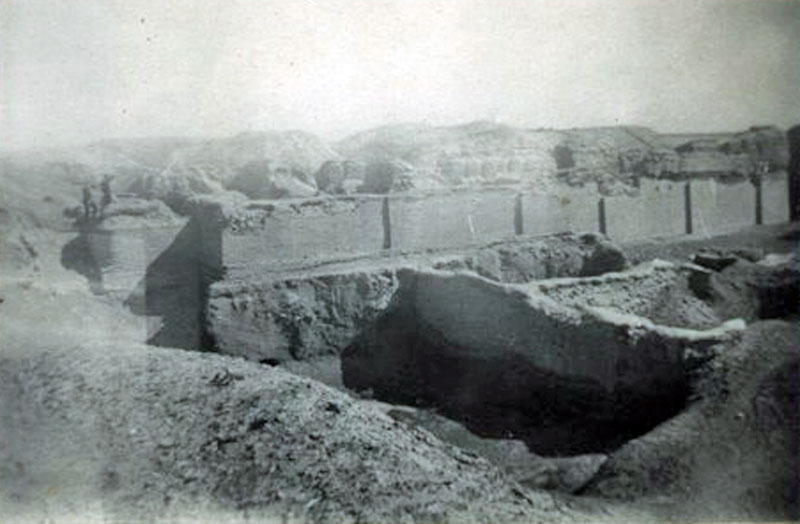
Padre's visit to Ur of the Chaldees, Iraq. This is the Biblical site of Abraham's birth. Image from Keith Butler
The Garden of Eden
The visit to the Garden of Eden was made by a small river boat hired for the occasion by the Chaplain, and again involved an early start. The Garden of Eden is located at the confluence of the Tigris and Euphrates Rivers at a place called Al-Qurnah, a distance of about forty miles.
The Shat-el Arab remains quite wide all the way to Al-Qurnah but we took a course close to the western bank which enable us to see some of the life and work being carried out on the fertile river land adjoining the river. There were irrigation channels reaching into the farmland, houses were very few and primitive by Western standards. Palm trees abounded and every so often, what appeared to be very basic brick kilns could be seen using the local clay. We were also fascinated by what appeared to be floating hayricks moving downstream on the current. They were in fact barges carrying reeds to a height of about twelve feet or more, manned by two or three crew who sat on the top of reeds! They did not seem to have much control of there destiny, but no doubt the had been doing the same thing for centuries.
We arrived at Al-Qurnah at about 11.30 and landed directly into the small area then kept as the Garden of Eden from the west bank of the Tigris. It measured about 10 x 30 yards and comprised of a grassed enclosure with three or four fruit trees growing in a line and alongside them the dead trunk of another tree. These trees were reputedly direct descendants of the tree from which Adam picked the fruit to give to Eve!! The dead trunk is reputedly the remains of the tree from which Adam picked the fruit!!!! Incidentally the fruit was not an apple. At the time we visited (November) the fruits were only about the size of a damson, but green, and I imagined that when they were full grown they would have been something akin to a plum.
It did not take too long to complete this sight seeing so we started to explore the rest of the "city". We followed the main street where there was a busy fruit and vegetable market in progress. At the far end of the street, probably half a mile away from our landing place, we came across a large and substantial building with an Iraqi flag flying from a flagpole. Our curiosity was raised, and someone, who shall be nameless suggested that the flag would make an excellent trophy! There did not appear to be any one around so two of our group went through the gates towards the flagpole which was about 20 yards from the gateway. Just as they were nearing the flagpole, a man appeared round the corner!
He was the Head Master of the school that the building turned out to be. The strategy was changed in a flash, and expressed our curiosity in the building whereupon the Head invited us in and showed us around. We of course explained our reason for visiting Al Qurnah and he then produced a large map, in Arabic, of the British Isles and hung it on the wall. He then went round us all in turn asking us to point to where we lived. He then translated the Arabic into English, and if we were lucky, or our geography up to scratch, we heard the name of our home town. (Fortunately, I managed "Stafford" first time.)
At about this time school finished for the day, and after our thanks and farewell to the Head we were accompanied by a goodly number of the pupils back to the Garden of Eden where one young lad produced a penknife and proceeded to carve us all a piece of wood from the tree from which Adam had supposedly picked the fruit for Eve!! We then boarded our boat and proceeded down stream to Basra and HMS Gambia.
Keith emailed me again in October 2018 and went over some of this again with some new details:
I remember our time in the Gulf. It was In Bahrain that we took on some awful water that turned "Daz" into something resembling wallpaper paste. The poor old stokers had to clean ot the fresh water tanks before relying on our own evaporated seawater. I think it was at Calcutta that there were dead cow, sacrificed to the Ganges on death, that rendered the evaporated seawater unfit to drink.
The other thing I remember of Calcutta was an afternoon at the races and evensong in the cathedral followed by a soiree at the bishops palace where we sang around the grand piano. Back to the Gulf, when Iraq had a king and Iran a Shah, we again enjoyed excellent hospitality. I visited the garden of Eden and Ur from Basra and in Abadan the ship was challenged to an athletics contest by the refinery. I recall throwing the javelin against the guy who had represented Iran at the Olympic games in 1952!
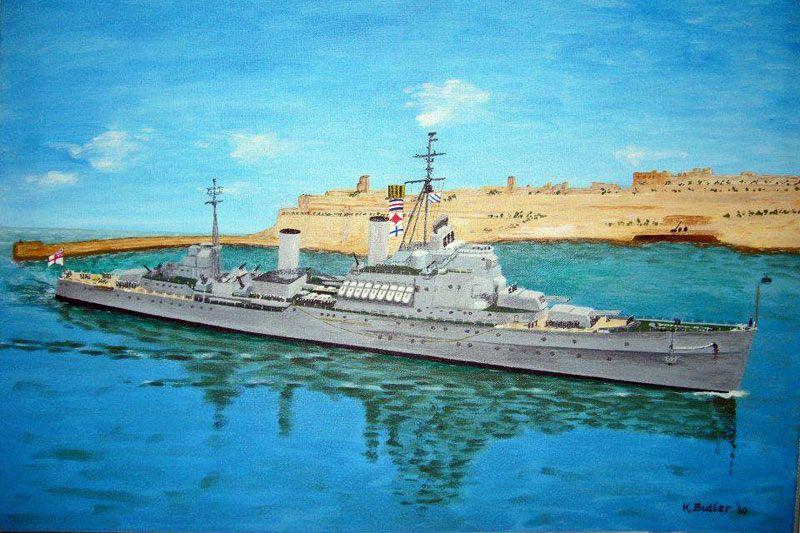
A painting by Keith Butler showing HMS Gambia entering Grand Harbour, Malta
Keith also very kindly sent the following photographs for the site:
